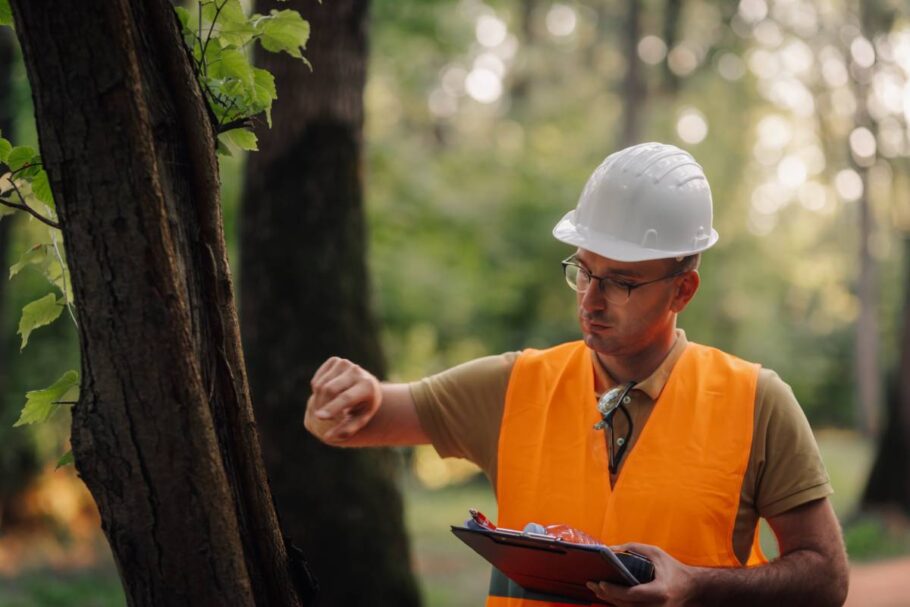We’ll explores why inspecting trees after an earthquake is so important, what signs to look for, and how professional arborists can help.
On average, around 100 earthquakes of magnitude 3.0 or more are recorded in Australia each year. While many are minor and go unnoticed, earthquakes above magnitude 5.0 — such as the destructive 1989 Newcastle quake — occur roughly every one to two years, and a potentially damaging magnitude 6.0 event happens about once every decade. These figures remind us that even in a country not typically associated with major seismic activity, earthquakes remain a real and recurring risk.
When an earthquake strikes, most people immediately focus on checking buildings, homes, and infrastructure for damage — and rightly so. However, there’s another element of our environment that often gets overlooked: trees. Particularly large, mature trees that stand near houses, schools, or public spaces can pose a serious safety risk if damaged during an earthquake. What many don’t realise is that trees, much like buildings, can sustain hidden structural damage that makes them unstable and dangerous.
This article examines the importance of inspecting trees after an earthquake, the signs to look for, and how professional arborists assess and secure them.
Can Trees Really Be Damaged by Earthquakes?
Absolutely. While earthquakes primarily affect built structures, the force of ground movement also impacts trees. Strong tremors can loosen a tree’s root system — the very foundation that anchors it to the ground. When this happens, even a once-stable tree can begin to lean or shift.
In some cases, internal fractures can form in the trunk or main branches. These cracks aren’t always visible from the outside but can significantly weaken the tree’s structural integrity. Over time, such hidden damage can lead to tree failure, especially under strong winds or heavy rain.
Think of it this way: if a tree was already growing in compact soil or had shallow roots, an earthquake can compromise its balance even more. The result? A potential “ticking time bomb” that could fall unexpectedly days or weeks later.
Why Tree Inspections After an Earthquake Matter
Many people underestimate how dangerous a damaged tree can be. In reality, falling branches or a collapsing tree can cause serious injury, property destruction, or even fatal accidents. Post-earthquake tree inspections aren’t just about protecting the tree itself — they’re about safeguarding people and property.
Here’s why this step should never be skipped:
1. Reducing Risks to Life and Property
A large tree that’s become unstable could easily crush a vehicle, damage a home, or injure anyone nearby. Even a medium-sized branch falling from height can cause significant harm. A professional inspection helps identify such risks early, allowing you to take preventive action before an accident occurs.
2. Proactive Prevention, Not Reaction
Waiting until a tree shows obvious signs of leaning or cracking might be too late. Earthquake-related damage is often internal or underground. By conducting an inspection shortly after seismic activity, you can address structural weaknesses early — through pruning, cabling, or bracing — to restore stability.
3. Public Safety and Liability
For places like schools, hospitals, hotels, parks, and other public areas, safety obligations are even greater. If a tree were to fall and cause injury, property owners or local authorities could face liability issues. Regular post-earthquake tree assessments demonstrate due diligence and commitment to safety.
4. Peace of Mind
Beyond the technical reasons, knowing your property’s trees have been professionally inspected provides a sense of security — especially in regions prone to aftershocks.
What Does a Professional Tree Inspection Involve?
Tree assessment is much more than just “looking at” the tree. Certified arborists conduct a systematic evaluation using a mix of visual observation and diagnostic tools to determine a tree’s structural health.
Here’s what the process typically includes:
1. Visual Examination of the Trunk and Canopy
Experts look for visible cracks, splits, peeling bark, or fungal growth — all potential signs of stress or internal decay. They also assess the balance of the canopy to determine if the tree’s weight distribution has shifted after the earthquake.
2. Root and Soil Stability Check
The arborist inspects the base of the tree for uplifted soil, cracks around the root flare, or exposed roots. These are telltale signs that the root plate may have shifted. In severe cases, the ground might show subtle depressions or gaps where the roots have torn away from the soil.
3. Lean Assessment
If the tree appears to be leaning more than before, specialists use tools like an inclinometer to measure the angle. A small tilt may not be immediately dangerous, but if the lean increases over time, it could indicate progressive root failure.
4. Internal Decay Detection
Using devices such as a resistograph or sonic tomography, arborists can detect internal cracks or decay that aren’t visible from the outside. These tests measure how sound waves or resistance travel through the wood, revealing hidden weaknesses.
5. Risk Report and Recommendations
After completing the inspection, you’ll receive a comprehensive tree risk report detailing the tree’s condition, potential hazards, and recommended actions — whether that means bracing, pruning, soil reinforcement, or removal in extreme cases.
Who Should Get Their Trees Checked?
Not every property will need a detailed assessment, but the following groups should definitely consider one after any significant earthquake:
-
Homeowners with large trees close to houses, fences, driveways, or powerlines.
-
Schools, universities, and childcare centres where children play outdoors.
-
Hotels, resorts, and businesses that have landscaped gardens or outdoor seating areas.
-
Local councils or property managers responsible for parks, community areas, or street trees.
If you live in a region with recurrent seismic activity, it’s worth incorporating tree assessments into your post-earthquake safety checklist — just like checking for gas leaks or cracked walls.
Signs You Can Spot Yourself
While a professional inspection is always best, there are some warning signs homeowners can look for right after an earthquake:
-
Leaning or tilting trunks that weren’t previously noticeable.
-
Cracks in the soil around the base of the tree.
-
Raised or lifted roots, especially on one side of the tree.
-
Hanging or broken branches high up in the canopy.
-
Fresh cracks or splits in the trunk or major limbs.
-
Sudden changes in foliage (e.g., leaves wilting or turning brown quickly).
If you notice any of these issues, avoid standing or parking near the tree and call a qualified arborist immediately.
The Cost of Neglect
Failing to inspect your trees after an earthquake can have serious consequences. There have been numerous cases globally where post-quake tree collapses caused secondary accidents days after the seismic event.
Beyond the risk of injury, dealing with emergency tree removal after a collapse is typically far more expensive than preventive maintenance. Insurance claims can also become complicated if it’s determined that the tree’s instability was a known but ignored issue.
By contrast, proactive tree inspection and maintenance represent a small investment for long-term safety and peace of mind.
Strengthening Urban Resilience Through Tree Care
Healthy trees contribute to the beauty, shade, and ecological balance of our communities. But for trees to remain assets rather than liabilities, they need regular assessment — especially after natural disasters like earthquakes.
Tree inspections not only help identify risks but also promote a deeper understanding of how urban greenery interacts with the built environment. In a world facing more extreme weather and geological events, managing these interactions responsibly is part of building resilient cities.
Final Thoughts
A well-maintained tree is a symbol of life, strength, and stability. Yet even the strongest trees can be compromised by unseen forces beneath the ground. After an earthquake, it’s crucial to look beyond walls and roofs — and give the trees around you the same attention.
Don’t wait for a near-miss or an accident to act. Whether you’re a homeowner, school administrator, or local council officer, scheduling a post-earthquake tree health inspection can make a real difference in community safety.
For professional assessment and expert advice on tree health, stability, and maintenance after seismic events, contact Wiktora Bros Tree Works — your trusted partner in responsible and safe tree care.





